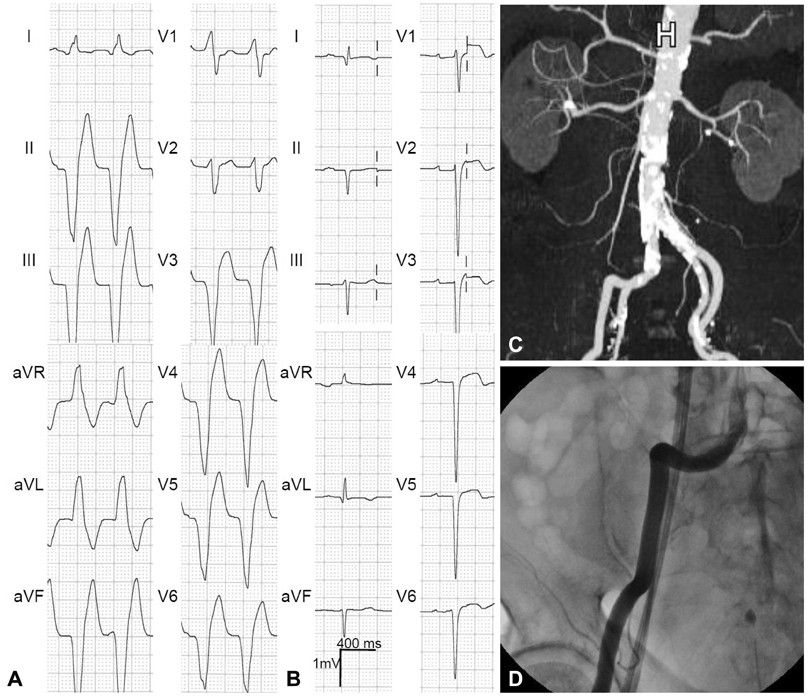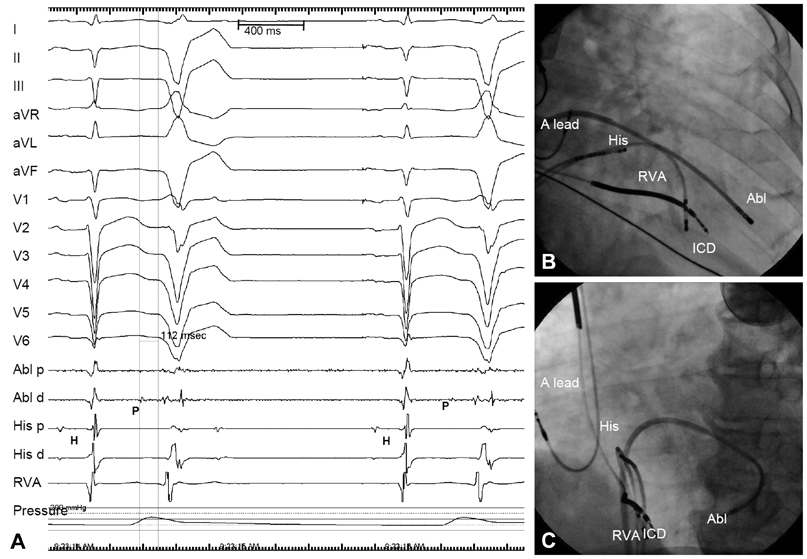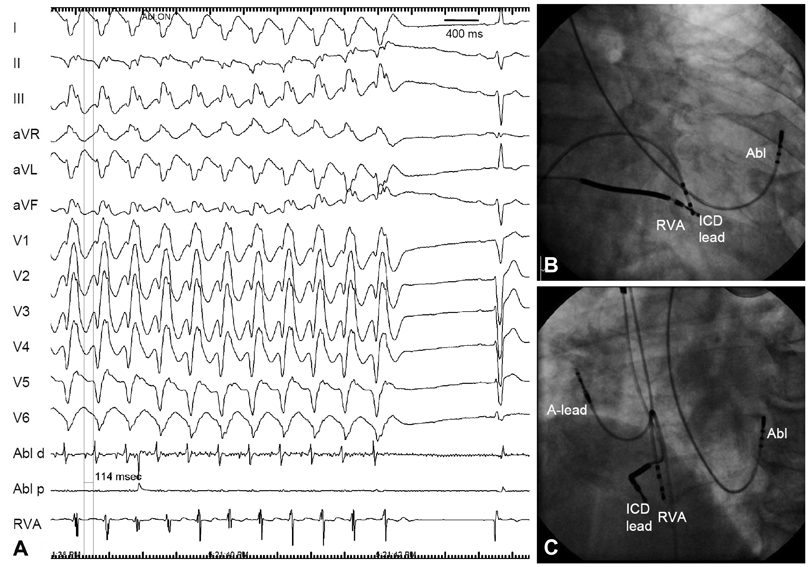Korean Circ J.
2012 Sep;42(9):632-637. 10.4070/kcj.2012.42.9.632.
Catheter Ablation of Ventricular Arrhythmias via the Radial Artery in a Patient With Prior Myocardial Infarction and Peripheral Vascular Disease
- Affiliations
-
- 1Division of Cardiology, Pusan National University Yangsan Hospital, Yangsan, Korea. mdjunkim@yahoo.co.kr
- KMID: 2297896
- DOI: http://doi.org/10.4070/kcj.2012.42.9.632
Abstract
- Herein, we present a case of a successful catheter ablation of ventricular tachycardia (VT) using a radial artery approach in a post-myocardial infarction patient, who had an implantable cardioverter-defibrillator and peripheral artery disease. Although the patient did not use antiarrhythmic drugs, the patient experienced no recurrence of VT during the following 3-year period.
MeSH Terms
Figure
Cited by 1 articles
-
Unusual Diaphragmatic Hernias Mimicking Cardiac Masses
Si Hun Kim, Myoung Gun Kim, Su Ji Kim, Jeonggeun Moon, Woong Chol Kang, Mi-Seung Shin, Wook-Jin Chung
J Cardiovasc Ultrasound. 2015;23(2):107-112. doi: 10.4250/jcu.2015.23.2.107.
Reference
-
1. Bhatt DL, Steg PG, Ohman EM, et al. International prevalence, recognition, and treatment of cardiovascular risk factors in outpatients with atherothrombosis. JAMA. 2006. 295:180–189.2. Kim JY, Yoon J, Jung HS, et al. Feasibility of the radial artery as a vascular access route in performing primary percutaneous coronary intervention. Yonsei Med J. 2005. 46:503–510.3. Choussat R, Black A, Bossi I, Fajadet J, Marco J. Vascular complications and clinical outcome after coronary angioplasty with platelet IIb/IIIa receptor blockade: comparison of transradial vs transfemoral arterial access. Eur Heart J. 2000. 21:662–667.4. Stevenson WG, Friedman PL, Sager PT, et al. Exploring postinfarction reentrant ventricular tachycardia with entrainment mapping. J Am Coll Cardiol. 1997. 29:1180–1189.5. Takemoto M, Yoshimura H, Ohba Y, et al. Radiofrequency catheter ablation of premature ventricular complexes from right ventricular outflow tract improves left ventricular dilation and clinical status in patients without structural heart disease. J Am Coll Cardiol. 2005. 45:1259–1265.6. Sarrazin JF, Labounty T, Kuhne M, et al. Impact of radiofrequency ablation of frequent post-infarction premature ventricular complexes on left ventricular ejection fraction. Heart Rhythm. 2009. 6:1543–1549.7. Friedman PL, Stewart JR, Fenoglio JJ Jr, Wit AL. Survival of subendocardial Purkinje fibers after extensive myocardial infarction in dogs. Circ Res. 1973. 33:597–611.8. Bogun F, Good E, Reich S, et al. Role of Purkinje fibers in post-infarction ventricular tachycardia. J Am Coll Cardiol. 2006. 48:2500–2507.9. Bogun F, Crawford T, Chalfoun N, et al. Relationship of frequent postinfarction premature ventricular complexes to the reentry circuit of scar-related ventricular tachycardia. Heart Rhythm. 2008. 5:367–374.10. Bänsch D, Oyang F, Antz M, et al. Successful catheter ablation of electrical storm after myocardial infarction. Circulation. 2003. 108:3011–3016.11. Szumowski L, Sanders P, Walczak F, et al. Mapping and ablation of polymorphic ventricular tachycardia after myocardial infarction. J Am Coll Cardiol. 2004. 44:1700–1706.12. Sarrazin JF, Good E, Kuhne M, et al. Mapping and ablation of frequent post-infarction premature ventricular complexes. J Cardiovasc Electrophysiol. 2010. 21:1002–1008.13. Credner SC, Klingenheben T, Mauss O, Sticherling C, Hohnloser SH. Electrical storm in patients with transvenous implantable cardioverter-defibrillators: incidence, management and prognostic implications. J Am Coll Cardiol. 1998. 32:1909–1915.14. Exner DV, Pinski SL, Wyse DG, et al. Electrical storm presages nonsudden death: the antiarrhythmics versus implantable defibrillators (AVID) trial. Circulation. 2001. 103:2066–2071.15. Hohnloser SH, Al-Khalidi HR, Pratt CM, et al. Electrical storm in patients with an implantable defibrillator: incidence, features, and preventive therapy: insights from a randomized trial. Eur Heart J. 2006. 27:3027–3032.16. Connolly SJ, Dorian P, Roberts RS, et al. Comparison of beta-blockers, amiodarone plus beta-blockers, or sotalol for prevention of shocks from implantable cardioverter defibrillators: the OPTIC Study: a randomized trial. JAMA. 2006. 295:165–171.17. Schreieck J, Zrenner B, Deisenhofer I, Schmitt C. Rescue ablation of electrical storm in patients with ischemic cardiomyopathy: a potential-guided ablation approach by modifying substrate of intractable, unmappable ventricular tachycardias. Heart Rhythm. 2005. 2:10–14.18. Lee DW, Kim J, Lee HC, et al. Catheter ablation of a left free-wall accessory pathway via the radial artery approach. Yonsei Med J. 2007. 48:1048–1051.19. Reddy VY, Reynolds MR, Neuzil P, et al. Prophylactic catheter ablation for the prevention of defibrillator therapy. N Engl J Med. 2007. 357:2657–2665.
- Full Text Links
- Actions
-
Cited
- CITED
-
- Close
- Share
- Similar articles
-
- Catheter Ablation of Ventricular Tachycardia in Patients with Post-Infarction Cardiomyopathy
- A Relation between Transient Myocardial Ischemia and Ventricular Arrhythmias on Holter Monitoring after Acute Myocardial Infarction
- 2018 KHRS Guidelines for Catheter Ablation of Ventricular Arrhythmias: Part 3
- Management of Acute Myocardial Infarction Patients With Ventricular Arrhythmias and the Prevention of Sudden Cardiac Death
- Acute Myocardial Infarction after Radiofrequency Catheter Ablation of Typical Atrial Flutter




